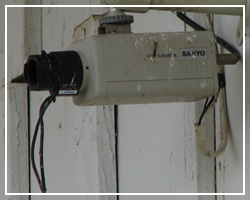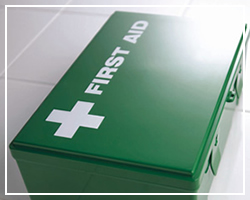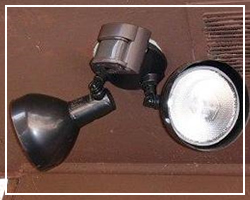Section 4. Safety and Security Measures
| Site: | Extension Foundation Online Campus |
| Course: | Farm Security |
| Book: | Section 4. Safety and Security Measures |
| Printed by: | Guest user |
| Date: | Saturday, December 27, 2025, 9:54 PM |
Description
Safety and Security Measures
Electronic Security
| Do you have barns, equipment, chemicals or other materials that are easily accessible? Learn how to make them more secure by taking additional security measures in Section 4. Electronic security devices can help protect your farm, but the cost  can only be justified if they have been recommended as a result of a credible security assessment. Your insurance agent and local law enforcement can make recommendations to help you determine your needs. Some types of electronic systems and devices are well suited for farmsteads.
|
Using Lighting for Safety and Security
|
Adequate lighting in the right places is important to the safety and Lighting dark areas may deter vandals and other criminals. Strategically placed lights will also allow you to safely check on your facilities or livestock at night, and to work after dark when necessary. Determine which facilities need to be well-lighted and which may require minimal security lighting. Your insurance agent or sheriff's office may be able to help you decide where lighting would be most effective and what type to purchase.
Abide by local light pollution standards in your area.
|
Farm Chemicals
All pesticide farm chemicals should be stored  in a secured area. Access should be limited to trained personnel. in a secured area. Access should be limited to trained personnel. Unauthorized access can range from a curious child to intentional trespass with the intent to steal or cause damage. Risks to health, the environment, and your business are obvious. Keep in mind that in many areas of the country, fertilizer is stolen for the purpose of producing illegal drugs. Responders to an emergency on your premises need to know where pesticides and other farm chemicals are stored. You can help them by centralizing your chemical inventory. Store everything in one isolated, fire-resistant (e.g., concrete block) building that is secured against theft and acts of vandalism and terrorism. Clearly mark the location on your farm map so that responders can tell exactly where your chemicals are stored. Emergency dispatchers should have your chemical storage location and your farm emergency response plan on file and readily available to police, fire, and Emergency Medical Services (EMS) personnel. Centralized storage also allows you and firefighters the option of letting the building burn (versus putting water on it) to minimize contamination of adjacent areas. Always return surplus pesticides to their designated storage areas. No exceptions.
|
Farm Chemicals Continued
Always read the pesticide label for specific storage requirements.  The chemical and the container in which it was purchased must be maintained in good condition. This is necessary to ensure that the material remains useful and to avoid environmental or human health hazards. Your pesticide storage area should meet the following requirements:
Also be sure to properly manage the chemical storage area.
|
Storing Veterinary Medicines
Veterinary medicines should be protected from changes in temperature, sunlight, dust, moisture, animals, and insects. Store medications in a clean, dry frost-free area. A farm office or utility room may be your most ideal location.
Use a clean refrigerator to organize and store drugs requiring refrigeration.
Check product labels for information on
- storage temperature
- light sensitivity
- expiration date
and store accordingly.
Discard expired products as recommended by the product manufacturer. Secure the storage units to prevent access by unauthorized individuals.
First Aid Kits
Well-stocked first aid kits should be kept in places accessible  to employees and other personnel. You can purchase first aid kits at many drugstores or assemble your own. Contents of a first aid kit might include:
Store all medications according to manufacturer's specifications. Check your first aid kits regularly, at least every three months, to be sure the flashlight batteries work and to replace supplies that have expired. |
Fire Protection
Fire is one of the most common farm emergencies. All buildings, including barns and sheds, should be free of flammable debris (i.e. cobwebs, trash, etc.) to reduce the risk of fire. Fire extinguishers should be placed in strategic locations and easily accessible so you will have one where and when you need it. Extinguishers should be the right size and type to combat electrical, fuel, or structural fires (refer to size and type fact sheet). There are several types of fire extinguishers available, but the best type for home and farm use is a multipurpose ABC type extinguisher.
|
